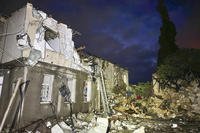 The United Kingdom's Tornado became the first fighter jet to fly with 3D printed parts in December.
The United Kingdom's Tornado became the first fighter jet to fly with 3D printed parts in December.
Done by BAE Systems, the Tornado was fitted with metal components constructed by a 3D printer. The plane then completed test flights at the end of December at BAE System's airfield in Warton, Lancashire.
The 3D printer constructed a protective cover for the cockpit radio, a protective guard for the landing gear and support struts on the air intake door, according to BAE Systems.
3D printing has gained a lot of momentum, especially in the defense and aviation industries. Companies such as General Electric featured 3D printers at their booths at the Paris Air Show this past summer to display the relatively new technology.
Aviation companies see 3D printing as a tool to produce specialized aviation parts cheaper. Feeding a design into a 3D printer is often cheaper than traditional methods of manufacturing, GE officials said in Paris.
"You are suddenly not fixed in terms of where you have to manufacture these things. You can manufacture the products at whatever base you want, providing you can get a machine there, which means you can also start to support other platforms such as ships and aircraft carriers," said Mike Murray, head of airframe integration at BAE Systems.
The Army's Rapid Equipping Force has deployed 3D printers to the front lines of Afghanistan as part of their Expeditionary Labs that come with experience engineers who develop parts and gear for soldiers on site.








